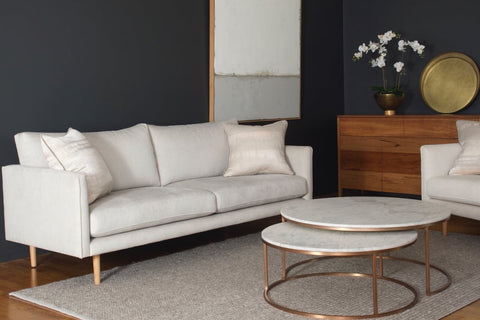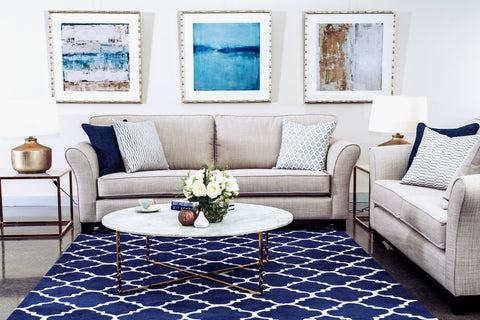Traditional homes offer uncompromised character when the architectural features are highlighted and the décor is complimentary. But if you feel like your interior is looking dated, it may be time to refresh your home by incorporating a few modern elements.
In this article, we discuss some of the best modern decorating tips for traditional homes. Our advice is ideal for those who want to bring their style up to the 21st century or who have recently moved into an older home. You’ll find tips from highlighting the home’s original features and layouts to choosing the right modern furniture and accessories.

Source: Canva.com
Utilise paint to disguise imperfections
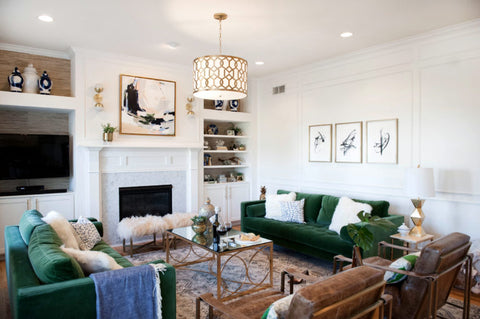
Sources: http://www.suburban-bees.com
One of the simplest and cost-effective ways to refresh your interior space is through paint. This is particularly the case with traditional homes you wish to bring up to the modern day. Older homes can look a little tired with marks on the walls and dents in the trim details, but these features are likely to have been one of the reasons you feel in love with the space in the first place.
The best way to highlight and preserve features such as such as moulding, doorway details and trim is through paint. Patch and prepare the surface and then consider painting the walls, ceilings and details all in one colour. This will help disguise some of the imperfections that have occurred over time. To add a certain level of polish, paint the mouldings and trim in a semi-gloss. In a modern interior, you can afford to be playful with your colour choices but if you want to have a clean, crisp palette, it’s hard to go past all white.
Restore original features
If you’re lucky enough to original features such as a timber balustrade or stained glass windows it’s worth restoring these to maintain the integrity of the home. Making the effort to replace the features that may have been removed in renovations will bring back a level of character and sophistication into the interior. Items like stained glass windows, fireplace mantels or ceiling roses should be celebrated and are considered valuable features to any home.
Try transitional styling

Source: www.studio-mcgee.com
Transitional styling is ideal for those who are moving away from their traditional look to embrace more modern furniture pieces and finishes. If you have pieces you’ve loved from another time such as family heirlooms you wish to keep, in this decorating style you can pair these with modern furniture or accessories.
Simply put, transitional style takes the best of both modern and traditional worlds to create the perfect balance between the two.
There is an art to achieving the transitional look without your interior looking like a hot mess. The key is to follow these main rules:
- Stick with a neutral palette and allow your furniture or art to be the focus. This includes walls and flooring as well as your soft furnishings.
- Position modern and traditional furniture pieces together such as contemporary chairs around an old dining table or a traditional occasional chair next to a modern sofa.
- Add contrast through finishes by using a mix of timber, rattan, metallics, lacquer and fabrics.
- Create balance by avoiding too much of any one style in the room.
- Steer away from over accessorising and instead opt for minimal accessories allowing the furniture and the architectural features of your room to be the hero.
Hang contemporary artworks
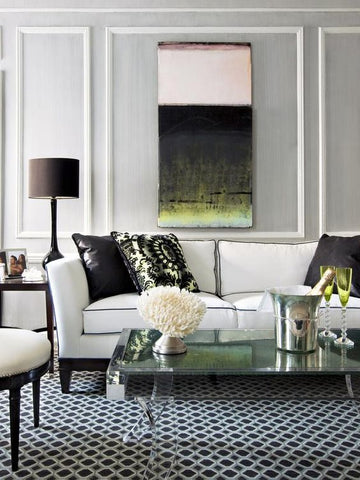
Source: timticks.com
Art can quickly transform your interior and can be helpful to personalise your home. Hanging contemporary pieces is also a great way to emphasise the transition style creating a juxtaposition between the traditional architectural features of your home.
Large format contemporary artworks can lift an older interior. If you don’t own large pieces, you could consider creating a gallery wall of smaller works to generate the visual impact your space may need. When selecting art, choose pieces that complement your existing furniture and décor.
It’s also worth considering what to do with your older artworks. When moving away from a traditional home, many homeowners question what they are to do with classic paintings and drawings framed within ornate frames. If you wish to incorporate these in your modern interior you can either hang them in a collection alongside contemporary pieces or reframe the works to give them a new lease on life.
Choose modern furniture wisely
Urban Rhythm's Nellie Sofa
Some modern furniture pieces will work better in a transitional style home than others. Quality pieces with clean lines will work nicely alongside the more ornate traditional pieces. Our Nellie Sofa is the perfect example of this.
Other things to consider when choosing modern furniture is the materiality. Modern pieces made from classic materials will connect to the heritage of your home. Marble topped coffee tables like the Elle will add a sense of polish to any interior. Likewise, incorporating modern timber pieces such as our Vista Dining Table into your space creates the balance modern traditional pieces require.
Furniture incorporating glass or metal can offer much needed visual relief when positioned in a room with older heavy timber or upholstered pieces too. This can instantly add a contemporary touch without needing to match with your traditional furniture.
Five quick tips for mixing different timber furniture
- Identify the dominant colour tone such as your timber flooring or large piece of furniture to use as the centre of your palette.
- Identify the undertones in the timber to keep in the same colour story. Some timbers are warm and others are cool. Find out what the dominant undertones are and continue this throughout your interior.
- Break up your timbers with fabric such as surrounding your timber dining table with upholstered chairs or laying a large area rug down on the floorboards.
- Select timber furniture with metal frame or legs such as our Soho Cirque Square Side Table to bring a feeling of lightness to the space.
- Mix in timber furniture that is lighter in appearance. Stools such as the Linea Tri Base Side Table or the Jervis coffee table aren’t as heavy as some of your traditional timber furniture pieces. This will help make the rooms feel larger and more contemporary rather than compact and dated.
Curate your accessories
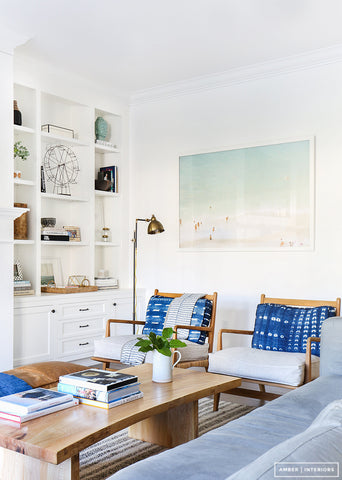
Source: http://amberinteriordesign.com/
Modern traditional homes are typically unfussy in design and have a sense of openness. The interior spaces aren’t filled to the brim with stuff. Rather, there is a feeling of space and visual relief running throughout the rooms.
When accessorising a traditional home in a modern aesthetic, you need to choose wisely. Be clear about the look you’re wanting to create, but you don’t need to be bound to only modern pieces. Remember, mixing the two eras in a transitional style is about balance.
Keep shelves open and airy and curate your accessories so that they don’t disturb or distract from the original architectural features of your home. You can even play with how you display your accessories such as arranging books stacked horizontally rather than the traditional way of lining them up vertically. Another way to emphasise your new style is to place modern accessories on traditional furniture pieces like a contemporary lamp on an older side table.
By curating your accessories with constraint, you’ll end up creating a gallery-like, personal feel with a modern touch.
Create zones in tricky layouts
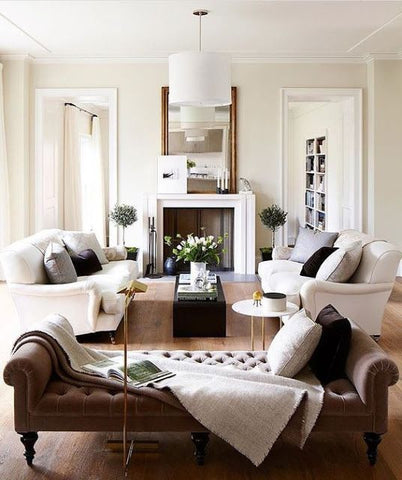
Source: best99homedecorpictures.us/
Traditional homes are renowned for tricky layouts that don’t often suit our modern lifestyles. Small rooms or long, narrow spaces that are difficult to work with can put people off trying to modernise the interior without knocking down walls.
You can make these spaces more functional by breaking up the longer, rectangle rooms into zones through furniture. What was once one large room filled with furniture, could be used as multiple, smaller spaces. Large area rugs in neutral tones, open shelving or furniture such as credenzas and bench seats are ideal for visually defining areas.
Use modern upholstery on traditional pieces
Urban Rhythm's Chloe Sofa
If you’re looking to revitalise your traditional interior chances are you’ve got several older furniture pieces. Before you plan on selling your furniture on Gumtree or taking it to the Salvos, consider whether getting rid of all your pieces is the best for your overall space (and budget). There is value in saving some of your traditional furniture. Many older pieces have been well made, are designed to be comfortable and have great lines. As we’ve mentioned previously, blending both traditional and contemporary styles also provides interest and personality to your space.
To bring your pieces up to the 21st century, reupholstering those that are in good condition or very loved may worthwhile. Choose a modern fabric either in a solid colour or large, fun print to breathe new life into your favourite pieces. For timber, check whether you can strip it back and re-stain it to suit your new interior space.
Keeping a few key traditional pieces and mixing it with modern furniture is a great way to respect the architecture while revitalising your interior.
You might also like
 Tips to make your home look more luxurious
Tips to make your home look more luxurious
 Styling tips for the perfect family home
Styling tips for the perfect family home

